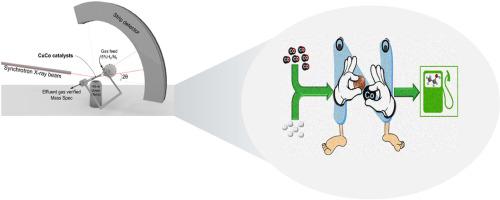Our official English website, www.x-mol.net, welcomes your
feedback! (Note: you will need to create a separate account there.)
Insights into mesoporous nitrogen-rich carbon induced synergy for the selective synthesis of ethanol
Carbon ( IF 10.5 ) Pub Date : 2020-10-01 , DOI: 10.1016/j.carbon.2020.06.076 Subhasis Das , Manideepa Sengupta , Renata Lippi , Jim Patel , Arijit Bag , Chandrani Nayak , Shambhu Nath Jha , Ankur Bordoloi
Carbon ( IF 10.5 ) Pub Date : 2020-10-01 , DOI: 10.1016/j.carbon.2020.06.076 Subhasis Das , Manideepa Sengupta , Renata Lippi , Jim Patel , Arijit Bag , Chandrani Nayak , Shambhu Nath Jha , Ankur Bordoloi

|
Abstract This work provides an in-depth study on selective ethanol synthesis over cobalt and copper supported on mesoporous nitrogen-rich carbon (MCN) materials. A series of nano-sized Cu–Co@MCN catalysts with variable compositions were designed to maximize the ethanol yield from bio-derived syngas (CO/H2 > 2) by utilizing a nitrogen-rich mesoporous carbon (MCN), which serves two purposes i) the stabilisation of relatively small sized Co nanoparticle crystallites (Co: below 10 nm, geometrical structural promoter) with strong metal support interactions and ii) the promotion of sufficient electronic interactions (electronic promoter) to improve the reducibility of the catalyst. Characterisation of these novel catalysts by a range of techniques (XRD, BET, TPR, HRTEM, XPS, and EXAFS) confirmed that the metal ions are confined within the MCN matrix with highly uniform dispersion. This enhances metal support interactions, which promotes associative CO adsorption over complete CO dissociation. The Cu–Co@MCN catalyst shows potential for higher alcohol synthesis with high product selectivity for C1–C3 oxygenates in the liquid product stream, making it an attractive solution to alternative synthesis of higher alcohols. To elucidate the actual role of surface support nitrogen in-situ synchrotron PXRD studies were performed on the catalyst systems as well as on traditional support alternatives, e.g., carbon nanotubes and activated carbon. Furthermore, insights on catalyst deactivation and selectivity were achieved by in-situ high temperature infrared spectroscopic analysis (DRIFTS) studies, which is followed by in-depth Density Functional Theory (DFT) calculations outline the plausible route via stabilisation of CHO∗, CH2O∗ intermediates for selective ethanol formation.
中文翻译:

深入了解介孔富氮碳诱导乙醇选择性合成的协同作用
摘要 这项工作深入研究了在介孔富氮碳 (MCN) 材料上负载钴和铜的选择性乙醇合成。一系列具有可变成分的纳米级 Cu-Co@MCN 催化剂旨在通过利用富氮介孔碳 (MCN) 最大限度地提高生物衍生合成气 (CO/H2 > 2) 的乙醇产量,其有两个目的i) 相对较小尺寸的 Co 纳米颗粒微晶(Co:低于 10 nm,几何结构促进剂)与强金属载体相互作用的稳定性和 ii)促进足够的电子相互作用(电子促进剂)以提高催化剂的还原性。通过一系列技术(XRD、BET、TPR、HRTEM、XPS、和 EXAFS) 证实金属离子被限制在 MCN 基质中,具有高度均匀的分散性。这增强了金属载体相互作用,从而促进了缔合 CO 吸附而不是完全解离。Cu-Co@MCN 催化剂显示出合成高级醇的潜力,对液体产物流中的 C1-C3 含氧化合物具有高产品选择性,使其成为高级醇替代合成的有吸引力的解决方案。为了阐明表面载体的实际作用,氮原位同步加速器对催化剂系统以及传统载体替代品(例如碳纳米管和活性炭)进行了 PXRD 研究。此外,通过原位高温红外光谱分析 (DRIFTS) 研究获得了对催化剂失活和选择性的见解,
更新日期:2020-10-01
中文翻译:

深入了解介孔富氮碳诱导乙醇选择性合成的协同作用
摘要 这项工作深入研究了在介孔富氮碳 (MCN) 材料上负载钴和铜的选择性乙醇合成。一系列具有可变成分的纳米级 Cu-Co@MCN 催化剂旨在通过利用富氮介孔碳 (MCN) 最大限度地提高生物衍生合成气 (CO/H2 > 2) 的乙醇产量,其有两个目的i) 相对较小尺寸的 Co 纳米颗粒微晶(Co:低于 10 nm,几何结构促进剂)与强金属载体相互作用的稳定性和 ii)促进足够的电子相互作用(电子促进剂)以提高催化剂的还原性。通过一系列技术(XRD、BET、TPR、HRTEM、XPS、和 EXAFS) 证实金属离子被限制在 MCN 基质中,具有高度均匀的分散性。这增强了金属载体相互作用,从而促进了缔合 CO 吸附而不是完全解离。Cu-Co@MCN 催化剂显示出合成高级醇的潜力,对液体产物流中的 C1-C3 含氧化合物具有高产品选择性,使其成为高级醇替代合成的有吸引力的解决方案。为了阐明表面载体的实际作用,氮原位同步加速器对催化剂系统以及传统载体替代品(例如碳纳米管和活性炭)进行了 PXRD 研究。此外,通过原位高温红外光谱分析 (DRIFTS) 研究获得了对催化剂失活和选择性的见解,











































 京公网安备 11010802027423号
京公网安备 11010802027423号